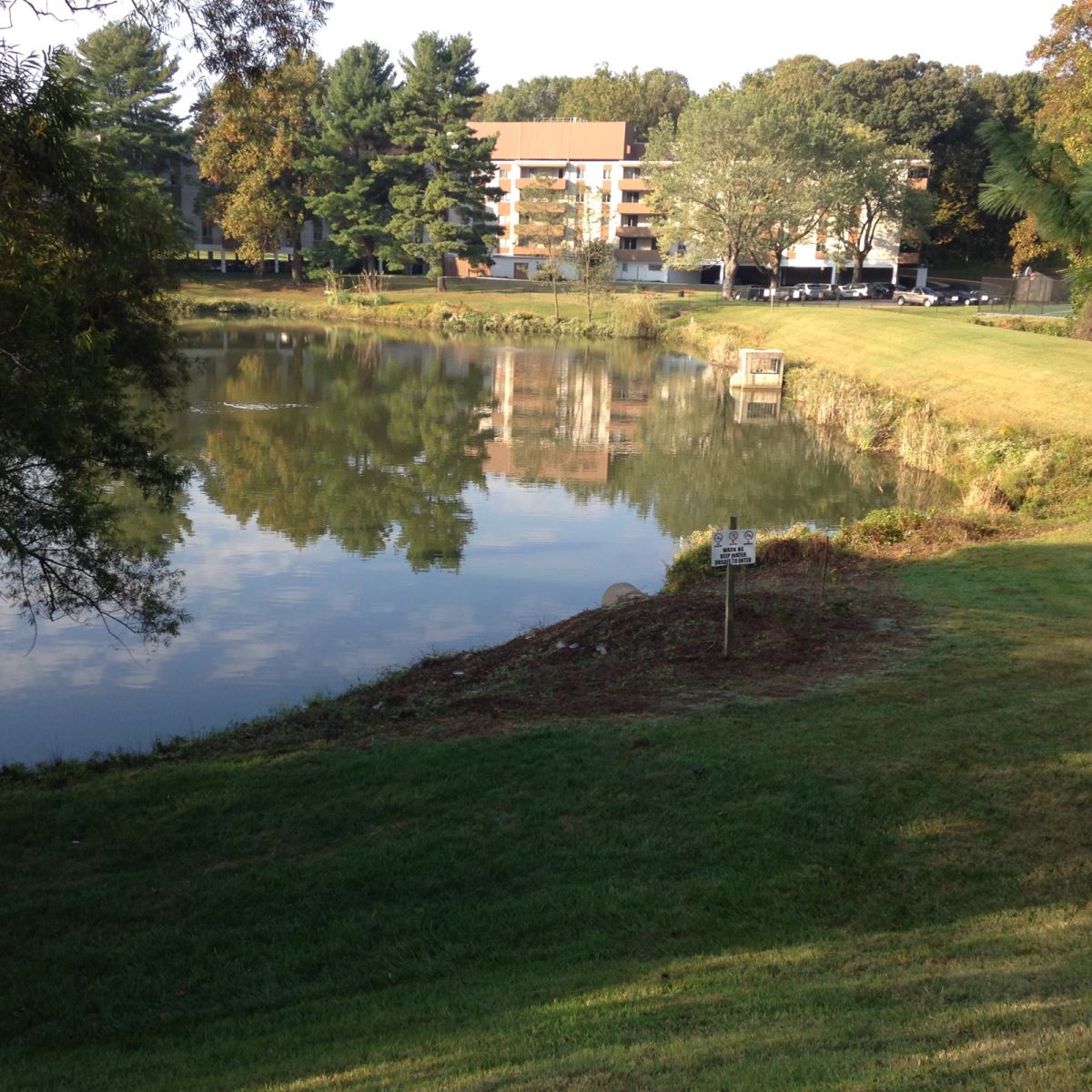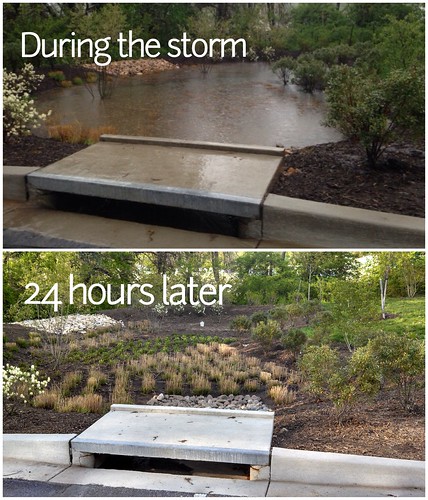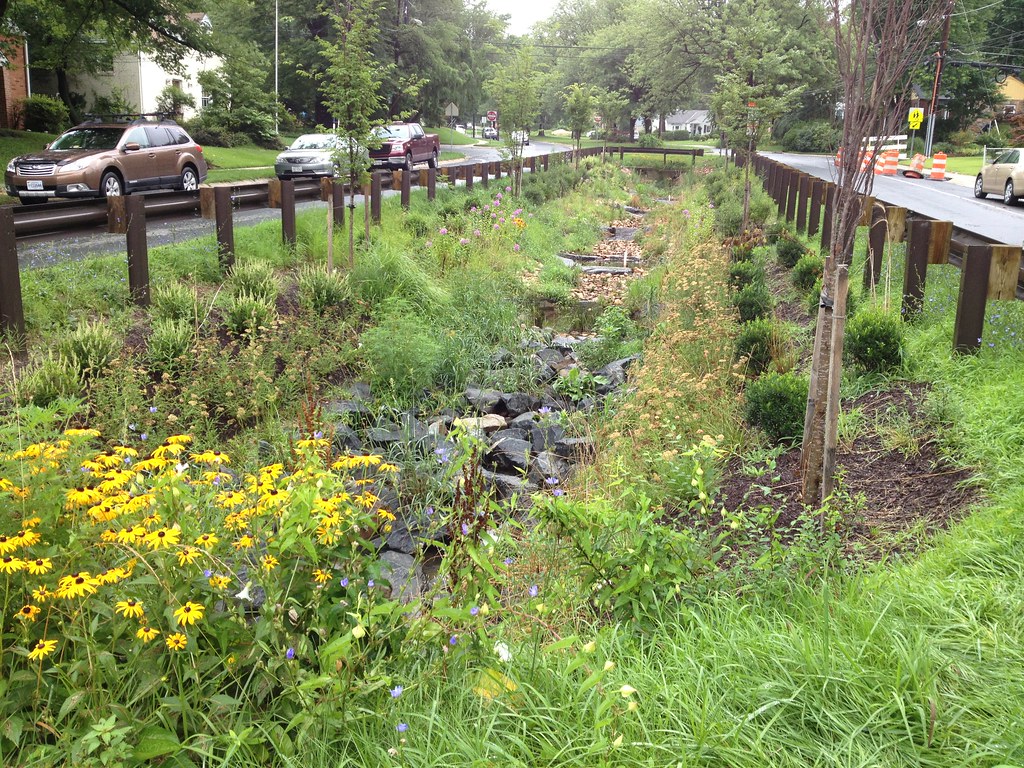Stormwater Management
Stormwater management facilities are often blamed for large numbers of mosquitoes, because the facilities contain rainfall runoff. But when a stormwater management facility is designed and maintained properly, it should not contribute to excessive mosquito populations.
What are Stormwater Management Facilities?
Per State of Maryland requirements, the Montgomery County Department of Environmental Protection regulates the management of stormwater facilities to prevent stormwater pollution in our waterways.
Stormwater management facilities are landscapes or structures that are used to remove pollutants, prevent stream damage and erosion, and prevent flooding. They include large scale infrastructure projects such as roadside rain gardens, retention ponds and underground stormwater storage, As well as homeowner installed RainScapes (such as rain gardens or rain barrels).
 A Stormwater Management Pond
A Stormwater Management Pond
Stormwater facilities have several functions:
- They slow, collect and store or absorb stormwater runoff from urban surfaces such as roads, parking lots, and rooftops.
- They remove contaminants from the runoff, cleaning it before it is allowed to discharge into local streams. This helps to safeguard our waterways. They are vital infrastructure in the urban environment.
There are thousands of stormwater management facilities in the County. Some of these facilities hold water permanently, while others hold stormwater temporarily.
If designed and maintained properly, stormwater management facilities should not support excessive mosquito populations because they:
- Drain water within a week or less;
- Contain moving water; or
- Contain predators that feed on mosquitoes (or mosquito predators)
 This bioretention garden drains water within 24-hours. Most will drain in two to three days
This bioretention garden drains water within 24-hours. Most will drain in two to three days

Mosquitoes do not breed in moving water. Fountains, like the one featured here, keep the water in wet ponds moving to prevent mosquitoes.
Stormwater management facilities that continuously hold water, such as wet ponds and stormwater wetlands, typically do not promote excessive mosquito populations because they contain ecosystems that include predators that feed on mosquitoes. Adult and larval mosquitoes are eaten by fish, frogs, tadpoles, dragonflies, and other aquatic wildlife.

Bioretention garden along Dennis Avenue drains in less time than it takes for mosquitoes to breed
Dry detention basins (dry ponds), bioretention and rain gardens are designed to capture and detain stormwater, allowing most of it to infiltrate back into the soil. Facilities fill up during storm events and then release the water within two to three days. Because these systems are designed to hold water for only short periods of time, less than the time needed for mosquito growth, they generally do not provide mosquitoes with enough time to reach maturity.
The Stormwater Facility Maintenance Program within DEP is responsible for inspecting and ensuring maintenance of all public and private (non-single family residential) stormwater management facilities within Montgomery County. Exceptions include those facilities located in Rockville, Gaithersburg and Takoma Park as these municipalities have their own programs.
I think the nearby stormwater management facility is the source of mosquitoes in my area. What should I do?
Although most mosquito issues on properties are not connected to stormwater management facilities, there may be occasions where the facilities are not functioning properly.- Most mosquito issues originate from small amounts of standing water in containers, potted plants, tarps, etc. The first step to reducing most mosquito issues is eliminating those sources of standing water. Sometimes trash left near stormwater facilities might be the source of the mosquitoes.
- If after checking and removing other potential mosquito sources, you still see large numbers of mosquitoes around a stormwater management facility, navigate to the the Montgomery County Stormwater Facilities Locator page and enter your address. Look for any green or red dots that represent a stormwater facility near your home.
- Write down the "Asset Number" - the number of the stormwater facility so that County staff can easily find your facility and direct you quickly towards the appropriate person.
- File a complaint through MC311. Please let the 311 Operator know the number(s) associated with the stormwater feature(s) if you have identified any near your home.
